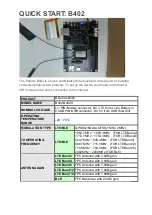
D-Link DWC-1000 User Manual
110
Section 4 - Advanced WLAN Configuration
Field
Description
DTIM Period
The Delivery Traffic Information Map (DTIM) message is an element included in some
Beacon frames. It indicates which client stations, currently sleeping in low‐power mode,
have data buffered on the access point awaiting pick‐up.
The DTIM period you specify indicates how often the clients served by this access point
should check for buffered data still on the AP awaiting pickup.
Specify a DTIM period within the given range (1–255).
The measurement is in beacons. For example, if you set this field to 1, clients will check
for buffered data on the AP at every beacon. If you set this field to 10, clients will check
on every 10th beacon.
Beacon Interval
Beacon frames are transmitted by an access point at regular intervals to announce the
existence of the wireless network. The default behavior is to send a beacon frame once
every 100 milliseconds (or 10 per second). The Beacon Interval value is set in milliseconds.
Enter a value from 20 to 2000.
Automatic Channel
The channel defines the portion of the radio spectrum that the radio uses for transmitting
and receiving. The range of channels and the default channel are determined by the
Mode of the radio interface. When the AP boots, the AP scans the RF area for occupied
channels and selects a channel from the available non‐interfering or clear channels.
However, channel conditions can change during operation.
Enabling the Automatic Channel makes APs assigned to this profile eligible for auto‐
channel selection. You can automatically or manually run the auto‐channel selection
algorithm to allow the controller to adjust the channel on APs as WLAN conditions
change.
By default, the global auto‐channel mode is set to manual. To enable the automatic
channel selection mode, go to the AP Management > RF Management page and select
Fixed or Interval for the Channel Plan mode. You can also run the automatic channel
selection algorithm manually from the Manual Channel Plan page.
Note
: If you assign a static channel to an AP in the Valid AP database or on the Advanced AP
Management page, the AP will not participate in the auto‐channel selection.
Automatic Power
The power level affects how far an AP broadcasts its RF signal. If the power level is too
low, wireless clients will not detect the signal or experience poor WLAN performance. If
the power level is too high, the RF signal might interfere with other
APs within range.
Automatic power uses a proprietary algorithm to automatically adjust the RF signal to
broadcast far enough to reach wireless clients, but not so far that it interferes with RF
signals broadcast by other APs. The power level algorithm increases or decreases the
power level in 10% increments based on presence or absence of packet retransmission
errors.
Initial Power
The automatic power algorithm will not reduce the power below the number you set in
the default power field. By default, the power level is 100%. Therefore, even if you enable
the automatic power, the power of the RF signal will not decrease. The power level is a
percentage of the maximum transmission power for the RF signal.
APSD Mode
Toggle to ON to enable Automatic Power Save Delivery (APSD), which is a power
management method. APSD is recommended if VoIP phones access the network through
the AP.
Frag Threshold
The fragmentation threshold limits the size of packets transmitted over the network.
Acceptable values are even numbers from 256‐2345. Packets that are under the configured
size are not fragmented. A value of 2346 means that packets are not fragmented.
Short Retries
The value in this field indicates the maximum number of transmission attempts on frame
sizes less than or equal to the RTS Threshold. The range is 1‐255.
Long Retries
The value in this field indicates the maximum number of transmission attempts on frame
sizes greater than the RTS Threshold. The range is 1‐255.
















































